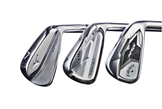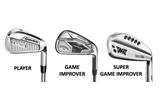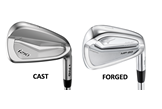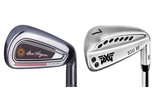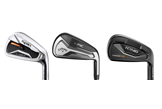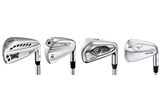How to choose your next set of forged irons
Published: Last updated:
For many golfers forged irons are the pinnacle of the game, up there on an aspirational pedestal as the hallmark of a decent ball striker.
Forged models have grown massively in popularity over the last five years and thanks to this renaissance there are now more of them on sale than ever before.
The best options don’t just cover off the needs of the world’s best pros, either; today, there are forged irons suited to high handicappers and average golfers, too, some boasting more face flex, ball speed and forgiveness tech than a driver. Simply put, more golfers than ever are considering forged irons as their next set.
So with TaylorMade, Mizuno, Callaway and Titleist all launching new forged models recently, now, through answering some simple questions (and our test results for 36 of the leading forged irons) we wanted to help you not only select which will best suit your game, but also show what you put on the line by making the wrong choice.
Jump to:
Question One: Are cast or forged irons my best option?
Question Two: What’s my ability?
Question Three: Should I consider Hollow Body irons?
Question Four: Can I accept strong lofts?
Question Five: How much can I spend?
Question 1: Are cast or forged irons my best option?

Historically, forged irons have come with premium prices, so they’re perceived as irons for serious golfers, which usually means better players. But just because forged irons are more expensive doesn’t mean they’re better.
The price difference comes down at least in part to the tooling costs involved in producing forged irons. Where cast irons need a single mould for each iron, stamping or pressing forged iron heads from a piece of steel (billet) can’t be done in a single step.
Four or five steps are required to squeeze the iron into shape, and a different tool is required for each step – which inevitably means extra cost.
Better players only?
Depending on which year you choose to analyse, 90-95 per cent of tour events are usually won with forged irons, which only adds to the idea that they’re for good players. In reality, though, as equipment prices have soared over the last five years forged irons have seen a huge renaissance, so there’s now a model to suit any golfer’s ability.
Ask yourself…
If you think your next set of irons should be forged, ask why?
Legendary forged iron makers like Mizuno will say the decision comes down to their premium feel and sound, whereas Ping (who are cast specialists) will argue that thanks to modern materials and processes, and by using elastomer as a damper, they can make cast irons feel just as good as any forged model.
The decision…
So why pick a forged iron? Taking the middle ground there’s very little performance gain from forged models, apart from the smaller size generally making them a little more workable. So let your decision come down to whether you can really feel a difference.
If you can, great. Also think about how they make you feel. If playing with a set of the softest irons available is important to you and they make you feel good about your game, then you should explore forged irons further.
ROBOT TESTED: Which golf ball suits my game?
Jump to:
Question One: Are cast or forged irons my best option?
Question Two: What’s my ability?
Question Three: Should I consider Hollow Body irons?
Question Four: Can I accept strong lofts?
Question Five: How much can I spend?
Question 2: What’s my ability?

Forged irons come in all shapes and sizes and are aimed at everyone from tour players to weekend warriors. It means there’s options for better players, game improvers and those needing ultimate forgiveness in the form of a super game improving model too. Here’s the benefits each construction type brings to the party.
Better Player Irons
Smaller profile
Better player irons are designed to appeal to decent golfers, and most above average players don’t want iron heads the size of shovels. Heads typically are shorter from toe to heel, which drops MOI and forgiveness (making the iron more workable).
Less offset means the centre of gravity is further forwards, too, which gives a lower ball flight. Most players’ irons also have thinner top lines.
Small cavity back
Players’ irons regularly have small cavity backs (apart from muscleback blades of course), but the size and depth will typically be smaller than you’ll find on game improver or super game improver models.
Often players’ irons won’t have fast face tech as some golfers at this level feel they can cause inconsistencies. You will though find springy faces on players’ distance irons with hollow bodies (like the new TaylorMade P790s and Ping’s i500s).
Weaker lofts
Better players tend to be less focused on distance with irons, and are more interested in accuracy. Slightly higher lofts help get shots landing on a steep descent which can help with shot to shot predictability.
Mizuno’s MP-20 MB 7-iron has a 34° loft whereas their JPX919 Hot Metal Pro is 30°, which is a full club difference. Golfers thinking about better player irons really shouldn’t be looking for distance; if you are, look very closely at players’ distance irons with hollow bodies.
Heavier shafts
Better player irons regularly come with heavier shafts like a 120g Dynamic Gold, whereas game improver models will often be 30g lighter. The extra weight allows the shaft to be designed to deal with the extra speed and forces that quicker swings generate, a trait of above average golfers.
Less offset, narrower sole
Blade and muscleback irons have the thinnest soles, as good players feel they can pick shots more cleanly off the turf. Less offset means the leading edge is much more in line with the hosel (rather than set behind it) which requires a solid downward strike to get shots airborne, especially in the longer irons.
TESTED: Which Mizuno MP-20 iron suits me?
Game Improver Irons
Bigger profile
By bigger, we don’t mean ugly. Where the size of a muscleback or players’ iron might scare the life out of you, game improver irons have a much more friendly, inviting appearance.
Callaway’s Apex 19 and PXG 0311 XF are brilliant examples of game improving irons that are designed to look like a player iron but combine those cosmetics with the playability of a cavity back.
Deeper cavity back
The deeper the cavity, the more mass can be removed from the centre of the iron and repositioned around the perimeter to increase off-centre hit efficiency.
Often, cavity irons will be made in two pieces which allows engineers to very precisely control where mass is positioned, as well as giving the flexibility to use a different material to construct the face.
Extra technology
Cup face and fast face tech are used on game improver irons to help golfers increase ball speed and carry distance. The faces are made as a separate part to the body and hosel so can be tuned, just like a driver face to deliver extra off-centre hit performance.
Some forged cavity backs also have shock dampening inserts to raise sound and feel levels over traditional cavity backs.
Strong lofts
Brands are well aware more golfers than ever now test new clubs on a launch monitor, and if their iron can deliver an extra six-10 yards over the competition, it pretty much seals the deal.
So most game improver sets have stronger lofts than their player iron cousins. To understand the gains and drawbacks of strong lofts, and see if your game’s suited to them, see question 4.
More offset and a wider sole
Most game improver irons have wider soles irrespective of whether they are forged or cast. A wider sole not only gets more mass below the equator of the ball, which improves playability, it also helps with turf interaction, ensuring the iron doesn’t dig too deeply into the turf, just like a wide-sole wedge.
Extra offset means the leading edge is behind the hands, giving a fraction more time to square the face at impact and positioning the centre of gravity slightly further back to help flight shots a little higher.
Lighter shafts
It’s simple physics – the lighter the shaft, the quicker you swing it. And the faster you swing, the further shots go.
Callaway’s Apex and Apex Pro irons are a great example of different shaft weights for different player types. The Apex 19 has a lighter, higher launching, higher spinning shaft, while the Apex Pro 19 has a slightly heavier, lower launching version.
TESTED: 2019 Irons ranked by forgiveness
WATCH: Which forged iron suits me?
Super Game Improver Irons
Largest profile
Irons don’t come any more forgiving. Bigger heads mean more weight can be placed around the extremities, preserving ball speed and playability on off-centre hits.
If you insist on forged irons you’ll see there aren’t many forged super game improver irons to choose from, and it comes down to how many golfers at this level can’t feel or notice the difference between cast or forged models.
SGI irons are sometimes low profile, which helps lower and deepen the centre of gravity (like PXG’s 0311 SGI Gen2).
Twice the difference
It’s common for the hosel offset, sole width and topline thickness of SGI irons to be twice or more than that of a better player model. All that mass in the right location aids stability and forgiveness.
Comparing Callaway’s Apex Pro 19 and Rogue X (not forged), the Rogue has 4.5mm more offset (3.22mm vs 7.7mm) in the 5-iron, which is huge. That plays a part at least in making the strong-lofted Rogue X playable.
Not always the strongest lofts
Lots of brands now recognise the average age of golfers is on the rise, so their most forgiving iron ranges are often aimed at moderate swing speed players. And moderate swing speeds need help launching shots higher, not lower, so these irons regularly have slightly more loft (than a distance orientated game improver model) to help average players flight shots for maximum distance.
Callaway’s game improving Epic Forged (with a 27° 7-iron) is a great example, compared to the company’s more forgiving Big Bertha iron (a super game improver) which has a 30° 7-iron loft.
Hybrid irons
Any golfers seriously considering a super game improver iron should also ask themselves if they can accept a whole set of hybrid irons. The hollow heads will offer ultimate forgiveness, but we completely understand some golfers struggle to accept playing the game with what is essentially a bag full of hybrids.
Sound and feel
Most SGI irons tend to be cast, rather than forged, because casting lets engineers more easily wring performance from these heads than forged alternatives.
If you’ve tried SGI irons before and never quite been sold on how they sound and feel, there’s never been a better time to give them another chance.
Engineers better understand how vibrations from oversized heads lead to sound and feel issues, and now counteract them with reinforcing bars and dampers.
TESTED: TaylorMade P790 2019 irons vs M5 vs P760 and P790 (2017)
Jump to:
Question One: Are cast or forged irons my best option?
Question Two: What’s my ability?
Question Three: Should I consider Hollow Body irons?
Question Four: Can I accept strong lofts?
Question Five: How much can I spend?
Question 3: Should I consider hollow body irons?

The rise of the hollow iron has been meteoric.
Most top brands now have at least one hollow iron in their range, and there’s a number of models which sit right on the fence between players’ and game improver models, which is a space notoriously difficult to fill.
With TaylorMade’s hollow P790s being among the most popular irons of the last two years, it’s no surprise there are now hollow models out there for everyone, from tour players to super game improvers.
How do they work: Speed
The hollow construction means there’s space behind the face which allows engineers to experiment with increasing face flex.
Some models have thin faces and a supporting material inside (SpeedFoam from TaylorMade or COR2 from PXG), which brands say boosts ball speeds and stops the face from caving in. Others models have strong but springy faces and unfilled heads. Either way, the idea is fast faces increase flex (not just in the centre, but across the whole face). And more face flex means more speed.
How do they work: Forgiveness
Compared to similarly sized heads that aren’t hollow, hollow models can be more forgiving. Why? The shape of the body allows weight to be positioned further from the face, which naturally increases MOI and forgiveness.
TaylorMade and PXG also say their filling material helps protect ball speed on off-centre hits, so golfers get better shot-to-shot consistency and smaller drop-offs between shots.
What do hollow irons bring to the table?
Ball speed and carry distance comparison, hollow body vs players’ irons
Players’ Irons
Ball Speed average: 121.15 mph
Carry Distance average: 171.08 yards
Hollow Irons
Ball Speed average: 123.29 mph (+1.77%)
Carry Distance average: 176.86 yards (+3.38%)
The drawbacks
There’s a group of golfers who, since the inception of fast face irons, feel shot consistency (especially backspin and carry) is compromised by fast faces and hollow body tech. These voices, though, have started to quieten in the last 18 months as the technology has developed.
A top R&D man recently told us hollow body irons will be in many tour player bags within 10 years, as they’re the clubs young players are growing up with today. TaylorMade’s P760s have also won on the PGA Tour in 2019.
The cost
As good as hollow irons sound they inevitably cost more to produce, and that’s down to their construction (two pieces welded together). All the hollow irons here have forged faces (that’s why they’re included), but on average costs tend to be 20-30 per cent higher.
Bearing in mind the price, the decision to go hollow is one you need to make for yourself. For us, six-14 handicappers who find it difficult to choose between players’ and game improver models, and who wouldn’t mind adding extra punch to their iron play, hollow irons will cover all bases.
TESTED: Callaway’s money no object Epic Forged iron
Jump to:
Question One: Are cast or forged irons my best option?
Question Two: What’s my ability?
Question Three: Should I consider Hollow Body irons?
Question Four: Can I accept strong lofts?
Question Five: How much can I spend?
Question 4: Can I accept strong lofts?

As launch monitors became more common in fitting and teaching studios, it became more important for brands to offer the longest iron available, as many club golfers buy on distance.So companies gradually strengthened their lofts, effectively turning a 7-iron into a 6-iron.
But it didn’t take long for golfers to realise they couldn’t launch a 5-iron (with the loft of a 4-iron) high enough, and with decent levels of spin to stop shots on a green, so so-called “loft jacking” started to get a bad name.
How do they work?
Thanks to more R&D, brands now understand how strong lofts work and build in specific features to ensure shots aren’t just launched low and hard with very little spin.
Extra offset positions the centre of gravity further back, helping flight shots higher; heads are designed to hinge around either the leading or top edge, which helps catapults shots upwards; And shafts in strong-lofted models are lighter, with softer tip sections, to increase launch and spin.
It all adds up to iron shots that now fly high enough to maximise carry distance and stop on a green.
Strong lofts vs Players’ irons
To show what effect strong lofts have, here’s a comparison between Honma’s strong-lofted T//World 747 P (28.5° 7-iron) and the more traditional Honma TWorld 747 V (32° 7-iron).
|
Honma TWorld 747 P |
Honma TWorld 747 V |
|
|
7-iron loft |
28.5° |
32° |
|
Ball speed |
126 mph |
122 mph |
|
Backspin |
5507 rpm |
6321 rpm |
|
Height |
25 yards |
28 yards |
|
Descent angle |
40° |
44° |
|
Carry Distance |
185 yards |
172 yards |
How do I know if they’ll suit me?
For moderate swing speed players who struggle to launch shots high into the air with traditional lofts, strong irons probably aren’t for you. But for golfers who hit high irons from the turf or tee, and just want more distance, they can be a revelation.
Make sure you can get the longest iron airborne easily, and don’t drop a ton of backspin. If you find yourself hitting lots of irons past the flag, you probably made a wrong choice.
TESTED: PXG’s half priced 0211 cast iron
Jump to:
Question One: Are cast or forged irons my best option?
Question Two: What’s my ability?
Question Three: Should I consider Hollow Body irons?
Question Four: Can I accept strong lofts?
Question Five: How much can I spend?
Question 5: How much can I spend?

It’s the million dollar question when you’re ready to buy, and you don’t need to be Einstein to realise costs have risen over the last few years.
Only you can answer the question, but with a good majority of forged irons now likely to set you back £1k or more, set yourself a budget and explore the options for the money you want to spend. Lovely forged irons are available from £550 to well over £3,000, so there’s plenty of choice no matter your budget.
Don’t overlook Ben Hogan
Ben Hogan are now an online-only business. It means you buy direct from them on the internet, which cuts out a retailer’s margin and means both parties get a great deal.
For some, buying on the internet is a leap of faith, but we’ve been really impressed with Hogan and when a set of Edge irons costs £535.58 plus shipping, it proves premium forged irons don’t have to cost the earth. Use their online fitting tool (www.benhogangolf.com) to get the right set-up.
Honma vs value for money?
Honma create some seriously expensive equipment (think gold plated cavity backs), but in fact (and we never thought we’d say this!) Honma’s forged irons, which start from £969, look like decent value for money when you consider what they bring to the party.
Honma have a big forging heritage in Japan, Justin Rose plays them on tour and our test results show they’re a very strong option at a similar price to big-brand rivals.
Mizuno haven’t ramped up prices
Most major brands have jumped on the back of PXG’s success of selling premium irons for more, introducing their own “designed without cost constraint” models. Titleist, Callaway, TaylorMade and Ping have all gone down the same road to some extent, but Mizuno have resisted.
Mizuno also sell irons individually, so if you want a 5-PW set you can pick up the brilliant JPX919 Forged for £135 a club or £810 for a set.
READ NEXT: 36 IRONS TESTED – Which forged iron suits me?
Jump to:
Question One: Are cast or forged irons my best option?
Question Two: What’s my ability?
Question Three: Should I consider Hollow Body irons?
Question Four: Can I accept strong lofts?
Question Five: How much can I spend?

